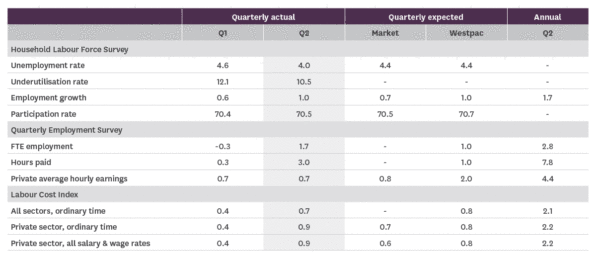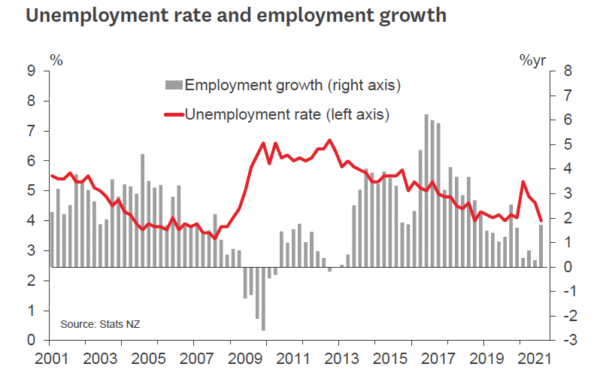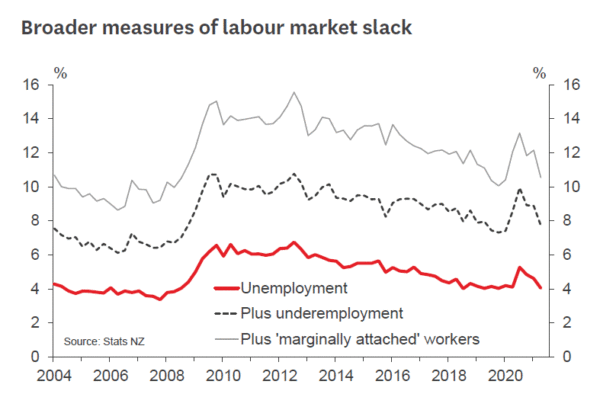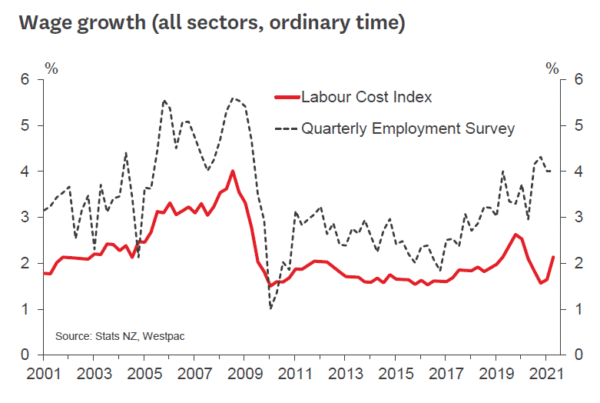- The unemployment rate fell to 4.0% in the June quarter, returning to its pre-Covid lows.
- The strong lift in employment indicates that a shortage of workers is not the main issue. Rather, demand for workers has been red-hot.
- Wage growth picked up strongly, especially in the private sector, as employers bid up to attract or retain workers.
- We continue to expect the Reserve Bank to start raising the OCR from this month, reaching a rate of 1% by the end of this year
The New Zealand labour market has tightened up even faster than we expected over the last few months. The unemployment rate dropped back to its pre-Covid low of 4.0% in the June quarter, and wage growth accelerated sharply after the subdued gains in previous quarters.
Today’s results highlight the fact that current labour market conditions are as much a product of hot demand as they are of supply-side constraints. The closure of the international border has effectively cut off the flow of migrant workers, and we’ve increasingly been hearing stories about skill shortages and poaching of existing workers. But it hasn’t been a zerosum game – employment is growing strongly on balance, and more and more people are being drawn back into the workforce.
These figures cement our view that the Reserve Bank will start to raise the OCR at this month’s Monetary Policy Statement with a total of three 25 basis point hikes by the end of this year. It’s becoming clearer that the domestic economy is running hot, and that the degree of monetary stimulus that we currently have in place is no longer appropriate.
Financial markets have now more firmly moved in favour of an August OCR hike, and are even pricing some chance of a 50 basis point move. We don’t see that as the most likely outcome, but we wouldn’t rule it out – the Monetary Policy Committee has already shown itself to be an activist one, and if they felt that 50 basis points of tightening was needed in total, they wouldn’t necessarily space it out for the sake of spacing it out.
Details
In the Household Labour Force Survey (HLFS), the unemployment rate fell to 4.0% in the June quarter, compared to a downwardly revised 4.6% in the June quarter. Unemployment peaked at just 5.3% after last year’s Covid lockdown, and is now back to its previous low point.
Other measures of labour market capacity told a similar story. The underutilisation rate had lifted to 12.1% in the March quarter – possibly due to the brief period that Auckland had spent at Covid Alert Level 3 – but has since dropped back to 10.5%. This was the lowest rate since March last year.
In the past we’ve estimated that a ‘neutral’ or non-inflationary unemployment rate is somewhere in the low 4’s. Some have suggested that the neutral rate could be temporarily higher right now due to skill mismatches, exacerbated by the loss of access to migrant workers. But either way, we’d argue that the economy is now operating beyond ‘maximum sustainable employment’ as set out in the RBNZ’s mandate.
The 1% rise in employment over the quarter was in line with our forecast. However, there was less of an assist than we expected from labour force participation – most of the rise in employment came out of the ranks of the unemployed. Participation is still a little below its pre-Covid levels, in part due to lower youth participation – more young people have gone into study in the last year, rather than heading overseas.
The Labour Cost Index (LCI) showed a strong increase in salary and wage rates compared to previous quarters. The overall increase of 0.7% was a little below our forecast of 0.8%, but that was due to subdued wage growth in the public sector (probably due to the ongoing wage freeze for higherpaying roles). Private sector wages rose by 0.9% for the quarter, to be up 2.2% on a year ago.
The Quarterly Employment Survey (QES) also showed a strong lift in employment and a pickup in wage growth. (The surprisingly soft readings in the March quarter were also revised away.) We had noted a sharp rise in employee earnings in recent months, based on tax data. The QES explained this as a strong lift in the number of hours worked, rather than a spike in average hourly pay rates.
We’ll review what these results mean for our forecasts over the next few days. We were already forecasting the unemployment rate to drop below 4% next year as the economy continued its post-Covid recovery. Since we’ve approached that point much sooner than expected, we’ll give careful consideration to how low it could go in this cycle.
Wage growth is likely to pick up further from here. Indeed, an annual increase of 2.2% is still below the peak reached in 2019, when the labour market was clearly getting tight. And with inflation higher today than it was back then, it appears that real wage inflation is only just beginning to stir.
















